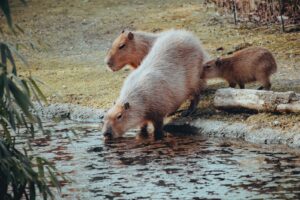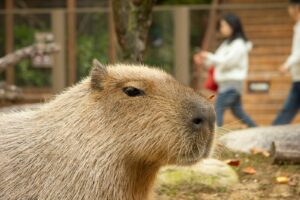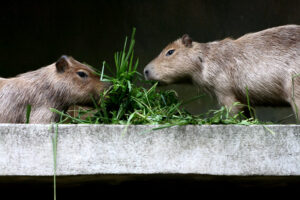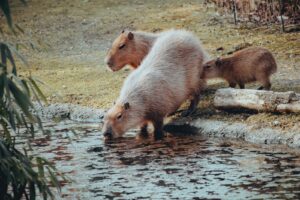Are you curious about the fascinating world of Capybaras? Wondering what they eat, where they live, or how they socialize? Look no further! In this article, we will dive deep into the most frequently asked questions about these adorable, social rodents.
From their habits and behavior to their diet and natural habitat, we will cover it all. Discover why these creatures are often dubbed “giant hamsters” and learn more about their close-knit family dynamics. Whether you’re a Capybara enthusiast or simply intrigued by nature’s wonders, this article will provide you with all the answers you seek.
Join us as we explore the secrets of the Capybara world and unravel the mysteries surrounding these unique creatures. Get ready to be charmed by their cute appearance and delightful antics. So, grab a cup of tea, sit back, and embark on an exciting journey to learn everything you ever wanted to know about Capybaras.
Capybara Habitat and Behavior
Capybaras are semi-aquatic mammals native to South America. They are typically found in dense vegetation near bodies of water such as rivers, lakes, and swamps. These social creatures are highly adaptable and can be found in various habitats, including grasslands, marshes, and forests.
In terms of behavior, Capybaras are known for their gregarious nature. They live in large groups called herds, which can consist of up to 100 individuals. These herds are often led by a dominant male, who is responsible for protecting the group. Capybaras are diurnal animals, meaning they are most active during the day, especially in the early morning and late afternoon. They have a hierarchical social structure and communicate through vocalizations, scent marking, and body language.
Capybaras are also excellent swimmers and spend a significant amount of time in the water. They have partially webbed feet, which make them efficient swimmers and allow them to navigate through their aquatic habitats with ease. Their ability to stay submerged for several minutes is a remarkable adaptation that helps them evade predators and find food.
In conclusion, Capybaras are highly adaptable creatures that thrive in a variety of habitats. Their social nature and aquatic lifestyle make them truly fascinating to observe.
What Do Capybaras Eat?
Capybaras are herbivores, meaning they primarily consume plant material. Their diet consists mainly of grasses, aquatic plants, and fruits. They have a unique digestive system that allows them to efficiently extract nutrients from their plant-based diet.
In the wild, Capybaras feed on a wide range of vegetation, including grasses, sedges, reeds, and water hyacinths. They are also known to eat bark, leaves, and stems from various trees and shrubs. Their diet is high in fiber, which helps with digestion and keeps their teeth healthy.
Capybaras have a specialized digestive system that utilizes bacterial fermentation to break down the tough plant material they consume. This fermentation process takes place in their large cecum, a pouch located at the beginning of the large intestine. The bacteria in their cecum help break down the cellulose found in plant cell walls, allowing Capybaras to extract nutrients from otherwise indigestible material.
It’s important to note that while Capybaras are primarily herbivorous, they have been known to occasionally consume small amounts of animal matter such as eggs and insects. However, these instances are rare and do not make up a significant portion of their diet.
In summary, Capybaras are strict herbivores with a diet consisting mainly of grasses, aquatic plants, and fruits. Their specialized digestive system allows them to efficiently extract nutrients from their plant-based diet.
Can Capybaras Be Kept as Pets?
Capybaras have gained popularity as exotic pets in recent years. Their friendly nature, intelligence, and unique appearance make them appealing to some individuals. However, it’s crucial to consider several factors before deciding to keep a Capybara as a pet.
First and foremost, Capybaras are social animals that thrive in groups. Keeping a single Capybara as a pet can lead to loneliness and behavioral issues. It’s recommended to have at least two Capybaras to provide them with the social interaction they require.
Secondly, Capybaras have specific habitat requirements. They need access to a large, secure outdoor enclosure with ample space to roam and swim. A pond or pool is essential for their physical and mental well-being. Capybaras also need plenty of vegetation to graze on and hide in.
Additionally, Capybaras are considered exotic animals in many jurisdictions, and owning one may require permits or licenses. It’s essential to research and comply with local laws and regulations before considering a Capybara as a pet.
Lastly, Capybaras require specialized care. They need a balanced diet consisting of fresh fruits, vegetables, and high-quality hay. Regular veterinary check-ups are necessary to ensure their health and well-being. Capybaras also need regular exercise and mental stimulation to prevent boredom and destructive behaviors.
In conclusion, while Capybaras can make fascinating pets for the right individuals, they require specialized care, social interaction, and a suitable habitat to thrive. It’s crucial to thoroughly research and consider all aspects of Capybara ownership before making a decision.
How Big Do Capybaras Get?
Capybaras are the largest rodents in the world, reaching impressive sizes. On average, adult Capybaras measure around 1.2 to 1.5 meters (4 to 5 feet) in length and stand about 50 to 60 centimeters (20 to 24 inches) tall at the shoulder. They can weigh anywhere from 35 to 66 kilograms (77 to 146 pounds), with females generally being smaller than males.
The size of Capybaras can vary depending on factors such as habitat, food availability, and genetics. Capybaras living in areas with abundant food resources tend to be larger than those in more challenging environments.
Newborn Capybaras, called pups, are significantly smaller than adults. They weigh around 1.5 to 2.2 kilograms (3.3 to 4.8 pounds) at birth and are born fully furred and with their eyes open. Pups grow rapidly and reach adult size within the first year of their life.
It’s worth noting that the size of Capybaras contributes to their role in the ecosystem. As large herbivores, they play an essential role in maintaining the balance of their habitats by grazing on vegetation and creating trails through dense vegetation.
To recap, Capybaras are the largest rodents in the world, reaching lengths of 1.2 to 1.5 meters and weighing between 35 to 66 kilograms. Their size contributes to their ecological role and helps them navigate their diverse habitats.
Are Capybaras Dangerous?
Capybaras are generally docile and non-aggressive animals. They are known for their gentle nature and social behavior. However, like any animal, Capybaras can become defensive if they feel threatened or cornered.
Capybaras have strong front teeth that they use for feeding, grooming, and defense. While their teeth can deliver a painful bite, Capybaras typically only resort to biting as a last resort when they feel extremely threatened.
It’s important to remember that Capybaras are wild animals, and their behavior can be unpredictable. Approaching or attempting to touch a Capybara without proper knowledge or permission can lead to accidents or injuries. It’s always best to observe Capybaras from a safe distance and respect their space.
In summary, Capybaras are generally not dangerous animals. They have a gentle nature and prefer to avoid conflict. However, it’s important to treat them with respect and observe them from a safe distance to avoid any potential risks.
Capybara Social Structure and Communication
Capybaras are highly social animals that live in large groups called herds. These herds are made up of multiple adult males, females, and their offspring. The social structure of a herd is hierarchical, with a dominant male leading the group.
Within the herd, Capybaras engage in various social behaviors to maintain order and communicate. They use vocalizations, scent marking, and body language to convey messages and establish social bonds.
Vocalizations are an essential part of Capybara communication. They produce a range of sounds, including whistles, barks, and purrs. These vocalizations serve different purposes, from warning the group of potential danger to signaling aggression or submission during interactions.
Scent marking is another crucial aspect of Capybara communication. They have scent glands located on their noses and backs that they use to mark their territories and communicate their presence to other Capybaras. By scent marking, Capybaras can establish and maintain social hierarchies within the herd.
Body language also plays a significant role in Capybara communication. They use various postures and gestures to convey their intentions and emotions. For example, a raised head and ears can indicate attentiveness, while flattened ears and a lowered head can signal submission.
In conclusion, Capybaras have a complex social structure and use various forms of communication to interact with others. Their vocalizations, scent marking, and body language are essential tools for maintaining social order and establishing bonds within the herd.
How Long Do Capybaras Live?
Capybaras have a relatively long lifespan compared to most rodents. In the wild, their average lifespan ranges from 8 to 10 years. However, Capybaras living in captivity tend to live longer, with some individuals reaching 12 to 15 years of age or even more.
Several factors can influence the lifespan of Capybaras. Genetics, diet, habitat quality, and access to veterinary care all play a role in determining their longevity. Capybaras living in well-maintained captive environments, with proper nutrition and medical attention, generally have longer lifespans than their wild counterparts.
It’s worth noting that the lifespan of Capybaras can also be influenced by predation and environmental factors. In the wild, Capybaras face threats from predators such as jaguars, caimans, and large birds of prey. The survival rate of Capybara pups is relatively low, as they are vulnerable to predation during their first few months of life.
To summarize, Capybaras have an average lifespan of 8 to 10 years in the wild, while those living in captivity can live up to 12 to 15 years or more. Proper care, nutrition, and protection from predators are essential for their well-being and longevity.
Where Are Capybaras Found in the Wild?
Capybaras are native to South America and can be found in several countries across the continent. They are most commonly found in the tropical and subtropical regions of Brazil, Argentina, Paraguay, Bolivia, and Uruguay.
Within these countries, Capybaras inhabit a variety of habitats, including wetlands, savannas, and forests. They prefer areas with access to water, such as riverbanks, marshes, and swamps, where they can swim and find food.
Capybaras have a wide distribution and are considered a species of least concern by the International Union for Conservation of Nature (IUCN). However, local populations might face threats due to habitat loss, hunting, and pollution.
Conservation efforts are in place to protect these unique creatures and their habitats. These efforts include the establishment of protected areas, educational programs, and research initiatives aimed at better understanding Capybara behavior and ecology.
In conclusion, Capybaras can be found in various countries in South America, particularly in Brazil, Argentina, Paraguay, Bolivia, and Uruguay. Their ability to adapt to different habitats has contributed to their wide distribution across the continent.
Capybara Conservation Efforts
Capybaras, while not currently endangered, face various conservation challenges. Habitat loss due to deforestation, urbanization, and agricultural expansion is a significant threat to their populations. Wetland degradation and pollution also pose risks to their survival.
To protect Capybaras and their habitats, several conservation initiatives have been implemented. These initiatives focus on habitat preservation, restoration, and the establishment of protected areas. By safeguarding the natural environments where Capybaras live, these efforts aim to ensure the long-term survival of these unique creatures.
Educational programs are also crucial in raising awareness about Capybaras and their ecological importance. By educating local communities and the general public, these programs promote conservation practices and encourage responsible interactions with Capybaras and their habitats.
Research is another vital aspect of Capybara conservation. Scientists study their behavior, population dynamics, and habitat requirements to gain a better understanding of their needs and develop effective conservation strategies.
In summary, Capybaras face conservation challenges due to habitat loss and degradation. However, ongoing conservation efforts, including habitat preservation and protection, are crucial for ensuring the continued survival of this unique and important species.






